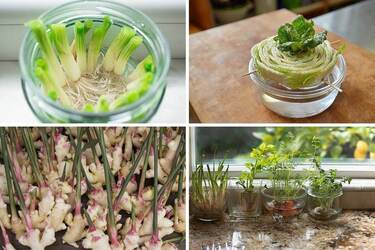Fresh herbs from waste: How to sprout plants from leftovers by dipping the roots in water

One of the most exciting and easy ways to grow fresh vegetables and herbs is to grow plants from leftovers by dipping the roots in water. This method is used to recycle eaten vegetables into new fresh plants.
Read also: For the forgetful: Which houseplants need the least care
Start your own small garden using this simple and cost-effective method of growing. In this article, we'll take a closer look at the process of growing vegetables in water and share useful tips to help you get the results you want.
- Lettuce: Growing lettuce from the ends is one of the easiest ways to get fresh herbs. After using the top of the lettuce, leave a few centimeters of the stem with the leaves. Place it in a glass or small container of water so that the bottom of the stem is covered with water. Place the container in a lighted place such as a windowsill or window board. After a few days, you will see new leaves and your fresh salad will be ready for harvest;
- Onions: They can also be grown from the ends by dipping their roots in water. After using the top part of the onion, leave a small part of the stem with the roots. Place this part in a vessel with water so that the roots are covered. Place the vessel in a brightly lit place and allow time for the onions to grow back. After a few weeks, new roots and leaves will appear, indicating a successful growing process. Once the onion has grown well, you can transplant it into a pot of soil and continue to care for it to get a full-fledged plant;
- Herbs: Many types of herbs can also be grown from scraps. For example, mint, basil, rosemary, and lavender can easily grow back if you dip their stems in water. Cut shoots about 10-15 centimeters long and set them in a glass or vessel with water. Provide them with adequate lighting and change the water every few days to avoid rotting. After a while, you will see new roots and the herbs will be ready to be transplanted into pots with soil.
Use plain filtered or settled water to grow your plants. Avoid using chlorinated water as it can interfere with the growth process. Change the water in the vessel periodically to avoid the growth of bacteria and odors.
Follow the lighting recommendations. Most plants need bright but diffused light for healthy growth. Follow the watering rules. Add small amounts of water to the vessel as needed to provide sufficient moisture for the plants.
Growing plants from water is just the beginning. Once the plants have grown sufficiently, they can be transplanted into pots with prepared soil for further cultivation.
As a reminder, we've already written about which houseplants are worth planting at home.
If you want to receive the latest news about the war and events in Ukraine, subscribe to our Telegram channel!
